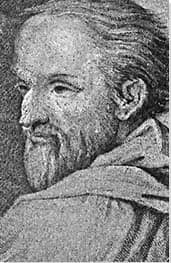Summary of Antonio da Correggio
For an artist who barely saw middle age, and who left behind just 40 or so authenticated works, Antonio da Correggio still ranked as the preeminent painter of the Parma School. As one of the most influential painters of the High Renaissance, Correggio absorbed elements of Leonardo, Raphael, Michelangelo and Mantegna while still managing to create oil paintings and frescos with a distinctive signature style. Indeed, his use of chiaroscuro, intense foreshortening, trompe l'oeil illusions, and other perspectival devices combined to infuse his religious and mythological narratives with a sense of pictorial drama that anticipated the emergence of the Baroque and Rococo styles. Correggio was also considered a sublime colorist who executed his highly sensuous mythological narratives with such an exquisite subtlety of touch they appealed even to the most conservative tastes of his day.
Accomplishments
- Early works, such as Madonna and Child with Saint Francis (1514), showed Correggio to be a prodigious talent whose work fully complemented that of the other great Northern Italian Masters. His sophisticated application of linear perspective, chiaroscuro, and sfumato prompted the famous Renaissance art historian, Giorgio Vasari to declare that "no craftsman ever painted with greater delicacy or with more relief" than Correggio.
- Through masterpieces such as The Vision of St. John on Patmos (1520-23) and The Assumption of the Virgin (1524-30), Correggio is credited with transforming dome interiors into spectacular swirling, symphonia-like, compositions. His mastery of di sotto in su foreshortening and dramatic lighting effects gave the transfixed viewer the sense of being physically "pulled upward" into heaven. His magnificently dramatic dome frescos did much to inspire the best of the seventeenth century Baroque painters.
- In his later mythological subjects, such as Leda and the Swan (1531-32), Correggio produced oil paintings with a palpable sense of seduction and eroticism. For an artist who was (according to Vasari) a melancholic and devout man, he produced canvases that might have been considered pornographic (for their time) were it not for the fact that Correggio rendered his naked and semi-naked subjects with a subtlety and lightness of touch that elevated them to the realm of wonderous beauty.
- Correggio made a fundamental contribution to the development of painting with a mythological and irreligious subject matter. He employed soft and delicate color contours as a means of counterbalancing his lines and of effecting a delicate balance between naturalism and poetics. Indeed, Vasari "held for certain that no one ever handled colours better than he".
The Life of Antonio da Correggio
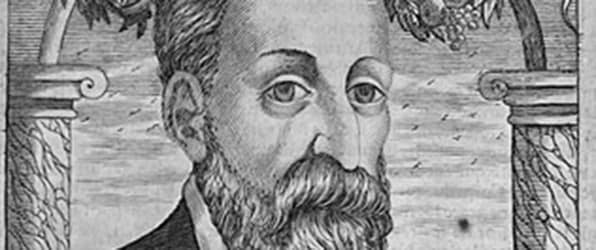
Commenting on the unassuming and withdrawn personality of Correggio, the eighteenth-century English essayist and philosopher William Hazlitt wrote that there is "nothing so remote from vanity as true genius" and that it was "almost as natural for those who are endowed with the highest powers of the human mind to produce the miracles of art, as for other men to breathe or move."
Important Art by Antonio da Correggio
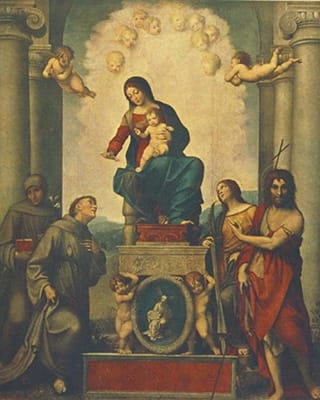
Madonna and Child with Saint Francis (or Madonna of Saint Francis)
In this early work the Virgin Mary, wearing red and blue robes, sits upon a throne at the center of the symmetrical composition, holding the naked Christ child on her lap. Behind her is an architectural setting, featuring Corinthian columns to either side, and a recessed niche onto which is painted a large white cloud directly behind the Virgin and child, as well as many cherubs (baby, winged angels) that form an arc over her head. At the top, in front of the architectural background, fly two full-bodied cherubs, one either side. the left of the throne is Saint Francis of Assisi, identifiable by the stigmata on his hands, bowing and looking up at the Virgin and child. Behind him stands Franciscan priest Anthony of Padua. The two figures to the right of the throne are Saint John the Baptist, and behind him, Saint Catherine of Alexandria.
This work was likely intended as the high altarpiece for the church of the Franciscan convent in the town of Reggio, though about a century later it was taken to Modena by Duke Francesco I d'Este to be hung in his palace. Town records suggest that Correggio produced the impressive work very rapidly, indicating his advanced talent for an artist of such a young age. In the work, the influence of Andrea Mantegna and Leonardo da Vinci can be noted, particularly in the use of linear perspective, chiaroscuro, sfumato, and softer, more delicate treatment of edges.
Oil on wood - Gemäldegalerie Alte Meister, Dresden
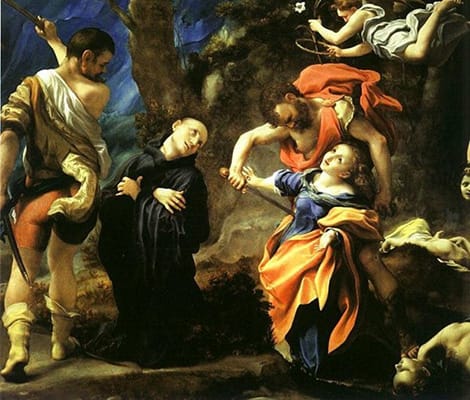
Martyrdom of Four Saints
This painting depicts the fourth century Christian martyrs, Saint Placidus, and his sister Saint Flavia. Laying behind them (to their left), and already dead, are sixth-century martyrs, Saints Eutychius and Victorinus (who were also siblings). Placidus and Flavia are being executed by two muscular Roman soldiers. The dramatic scene appears to be set in a forest, in front of a rocky outcropping. The dark-blue evening sky can be seen in the upper-left corner. In the upper-right corner is a small flying angel holds the palm of martyrdom as well as a halo.
This work, along with Deposition (or Lamentation) (1525), was commissioned by local nobleman Placido Del Bono and intended to decorate the side walls of the Del Bono Chapel in the church of San Giovanni Evangelista in Parma. As art historian Maddalena Spagnolo notes, "Given the rarity of the subject, Correggio did not have a solid iconographic tradition to refer to and this freedom, as often happens in great artists, resulted in an opportunity to set the image in an innovative and creative way". We see from his preparatory drawings that he experimented a great deal with the composition, initially arranging the work in a highly symmetrical manner. According to Spagnolo, however, it seems that he then considered the oblique angle at which the work would be seen in the chapel and opted instead for a more diagonal composition.
Spagnolo also notes that the final painting differs from Correggio's preparatory drawings in that he changed Saint Flavia's pose. In his drawings, she was shown with her face in profile and her right arm cross her chest, perhaps in a sort of defensive gesture. However, in the final version, he presents her, as Spagnolo writes, in "a more frontal position [...] with her arms open and her gaze turned to the sky in sweet and submissive acceptance of her martyrdom". It is quite possible that this pose served as inspiration for later works by other artists, including Ercole Ferrata's Death of Saint Agnes (1660-64), in which the young girl being martyred also holds her arms open, willingly accepting her fate.
Oil on canvas - Parma National Gallery, Parma
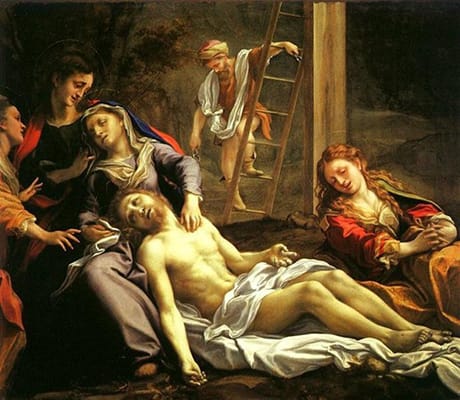
Deposition (or Lamentation)
This painting shows the moment immediately after Christ has been lowered from the cross (making Lamentation a more accurate title than Deposition). The dead body of Christ is front and center in the composition, while behind him and to the right, we see the base of the cross, and a ladder leaning against it. Descending the ladder is Nicodemus, who holds the pincers that he used to remove the nails from Christ's hands and feet in the deposition process. Christ's head rests in the lap of the grief-stricken Virgin Mary, who, in turn, is supported in her seated position by young Saint John. Mary Magdalene sits just behind Christ's legs, at the right-hand side of the image.
Like its companion work, Martyrdom of Four Saints (1524), Correggio's Deposition has a powerful luminous quality, and follows a diagonal composition, indicating that the artist took into consideration the oblique angle at which it was to be viewed in its intended location. However, art historian Maddalena Spagnolo argues that, when compared with Martyrdom of Four Saints, Correggio's Deposition "is in many ways more innovative [as] it marks a further development in the research dedicated to the representation of the 'motions of the soul' which had begun to interest Correggio starting from the second decade of the sixteenth century" and that this work served in fact as "a model for seventeenth-century artists who were able to develop its pathos in a baroque direction". Curator and art historian Giuseppe Adani also comments upon the powerful emotions, particularly shock and despair, conveyed through this work, and asserts that this and other works by Correggio directly influenced Italian Baroque painter Annibale Carracci.
Oil on canvas - Parma National Gallery, Parma
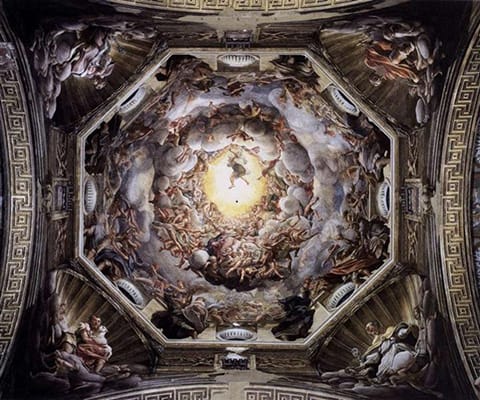
The Assumption of the Virgin
The art historian Esperanca Camara describes how, in 1522, a group of Parma's leading dignitaries had joined together to commission Correggio's fresco soon after the papacy had liberated Parma from French occupying forces. Camara notes that "In the sacred architecture of the Roman and Byzantine empires, domes were viewed as symbols of heaven" and that Correggio had "merged this symbolism with the Renaissance's fascination for three-dimensional illusion [transforming] the dome from a solid surface into heaven itself. The dramatic di sotto in su (from below to above) perspective [heightening] the reality of the illusion. As the first follower of Christ, the Virgin Mary personifies the Church, the community of the believers [and through] the Assumption's daring foreshortening, Correggio reassured Parma's citizens of the palpable reality of eternal salvation".
The Cattedrale di Santa Maria Assunta was Parma's most consecrated building and Correggio's fresco celebrated not only Parma's return to a Papal State but also "the final union of the faithful with the divine at the end of time". Indeed, in Correggio's narrative, "Frolicking angels, ranging in age from infants to adolescents, populate concentric bands of clouds that extend into the apex of the dome [as] Mary twists her body and opens her arms as she rises toward the golden light of heaven [her] obedience to God's will [making] her the chosen vessel of the Incarnation [and earning] her a place by Christ's side in heaven". Waterhouse concludes that the Assumption of the Virgin marked "the culmination of Correggio's career as a mural painter, and that his most famous fresco anticipated "the Baroque style of dramatically illusionistic ceiling painting" whereby the "entire architectural surface is treated as a single pictorial unit of vast proportions".
Fresco - Duomo di Parma (Cattedrale di Santa Maria Assunta)
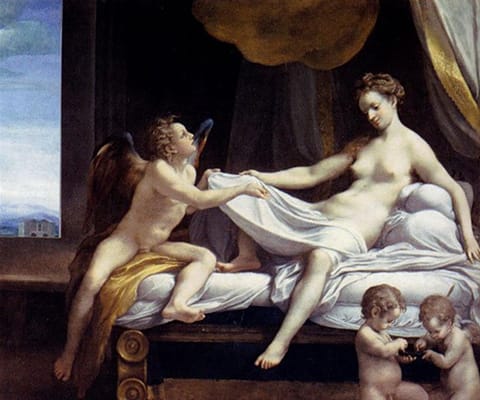
Danaë
Later in his career, Correggio turned from religious to mythological subject matter. Here, he presents the legend of Danaë, as told by the Roman poet Ovid in his Metamorphoses. Danaë was the daughter of Acrisius (the king of Argos), who was said to have been warned by an Oracle that a son of Danaë would murder him. The king had his daughter locked in a bronze tower to prevent this. However, the God Jupiter descended in the form of golden rain and impregnated Danaë with a son, Perseus, who eventually did carry out the prophecy. Correggio opted to present the most sensual moment of the myth, when Jupiter, represented as a golden cloud, floats down toward Danaë, who is being undressed by Eros, the Greek God of love and sex.
Eros appears to be holding a sheet over the legs of the nude, reclining Danaë, to catch the golden raindrops of Jupiter's seed and guide this toward her sexual organs. At the bottom-right corner, two putti strike gold and lead arrows against a touchstone, representing the test of love's endurance. Moreover, the fact that one putto is winged, while the other isn't, signifies the contrast between "sacred love" and "profane love". This work was commissioned by Federico Il Gonzaga, Duke of Mantua, along with seven other paintings focused on the mythical trysts and amorous interventions of the God Jupiter and was likely intended to decorate the Ovid Hall in the Palazzo Te of Mantua.
Despite its charged eroticism, Correggio handles the scene with a delicacy and sensuality that is found lacking in Titian's treatment of the same subject (1544-45). Art historian Ellis K. Waterhouse writes that it was in these later mythological works that Correggio "fully exploited the medium of oil painting. He was intrigued with the sensual beauty of paint texture and achieved his most remarkable effects in [this] series of mythological works [...] The sensuous character of the subject matter is enhanced by the quality of the paint, which seems to have been lightly breathed onto the canvas. These pictures carry the erotic to the limits it can go without becoming offensive or pornographic".
Oil on panel - Galleria Borghese, Rome
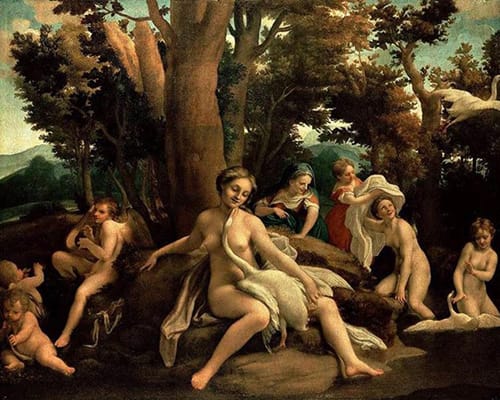
Leda and the Swan
The Ovidian myth of Leda and the Swan was painted by Correggio as part of his series on the Love Affairs of Jupiter (also for the Duke of Mantua). The myth tells that Jupiter took the form of a swan to seduce Leda on the banks of the river Eurota. In Correggio's version of this tale (a recurrent topic throughout art history), a nude Leda is shown at the center with the swan laying across her lap, its body being guided between her legs by her left hand, and its long neck twisting up between her breasts. In addition to this moment of lovemaking, Correggio presents simultaneously the pair's meeting on the lower right-hand side, as well as a third moment at the upper right-hand corner: the swan's departure as Leda dresses with the assistance of her handmaiden. On the left-hand side of the image, Correggio balances the scene by depicting Cupid with his bow and two putti with flutes.
This painting shows the influence of Michelangelo, whose treatment of the same subject matter demonstrated a similar sensual eroticism. Biographer Giorgio Vasari remarked that in this and other works, the artist "painted hair in detail, not in the precise manner used by the masters before him, which was constrained, sharp, and dry, but soft and feathery, with each single hair visible, such was his facility in making them; and they seemed like gold and more beautiful than real hair, which is surpassed by that which he painted". Vasari also praised Correggio's talent in painting the skin of Leda and others, writing that "so soft in colouring, with the shadows of the flesh so well wrought, that they appeared to be not colours, but flesh".
It is believed that this painting was originally hung to the left of Danaë, indicating that the swan Jupiter was flying out of this image to the right toward the Danaë painting where the bird transformed into golden rain. Leda and the Swan was, however, relocated several times over the next century, to Spain, Prague, Sweden before arriving in the collection of Philippe II, Duke of Orléans in France. However, Philippe's fervently pious son Louis found the work to be so depraved he attacked it with a knife, damaging Leda's face. The work was eventually restored in the eighteenth century. However, in the process of the restoration, Leda's lustful expression was subdued and presented as more chaste. However, it is still clear from the composition, as well as the satisfied look on the face of Leda as she watches the swan depart, that Correggio intended to present this encounter as a seduction rather than a violation. In 1939 the Austrian painter, Paul Mathias Padua, produced his own interpretation of the painting, Leda mit dem Schwan, which was bought by Adolph Hitler (for 5,000 Reichsmarks) for his second bedroom.
Oil on canvas - Gemäldegalerie, Berlin
Biography of Antonio da Correggio
Childhood
Correggio was born Antonio Allegri but became known as Correggio after the name of the small town of his birth - Correggio, referred to colloquially simply as Reggio - in northern Italy. His father's family is believed to have arrived from Florence, from where, his grandfather, Domenico, was exiled in 1433 because of his outspoken opposition to the powerful banker and politician, Cosimo de' Medici.
Little else is known of Correggio's early life but it is believed that his father, Pellegrino Allegri, was a local tradesman. Nothing at all is known of his mother. Some historians believe that Correggio was wholly self-taught, but it is highly likely that he received some artistic training from his uncle, Lorenzo Allegri, himself a painter of modest renown (but for whom there are no surviving works). There is some informed speculation that he may have also been a pupil of local painters Quirino Allegri (his cousin) and Antonio Bartolotti.
Education and Early Training
Between 1503-05, Correggio undertook an apprenticeship in Modena with Francesco Bianchi Ferrara, who himself was trained by the Early Renaissance painter, and co-founder of the School of Ferrara, Cosimo Tura. Correggio's early work, which consisted mainly of small-scale panels for local churches and monasteries, showed a high level of talent in anatomy, architecture, optics, perspective, and sculpture, and pointed to the influences of Lorenzo Costa, Francesco Francia, and Leonardo da Vinci. Correggio started experimenting with wall paintings, too, producing a variety of frescos that began the gain notice.
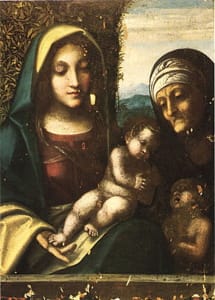
In 1506 Correggio moved to Mantua where he arrived shortly before the death of the famed early Renaissance painter Andrea Mantegna. It is thought likely that he produced the Madonna and the Child with St. Elizabeth and John the Baptist, which demonstrated the strong influence of both Costa and Mantegna, around 1510. In 1514 Correggio probably finished two round paintings (tondi), the Entombment of Christ and Madonna and Saints, for the Basilica of Sant'Andrea in Mantua where he also completed the decoration for the family chapel of the late Mantegna. Arts professor Ellis K. Waterhouse notes that "Although his early works are pervaded with his knowledge of Mantegna's art, his artistic temperament was more akin to that of Leonardo [...] who had a commanding influence upon almost all of the Renaissance painters of northern Italy". Waterhouse states, moreover, that whereas "Mantegna uses tightly controlled line to define form, Correggio, like Leonardo, prefers chiaroscuro, or a subtle manipulation of light and shade creating softness of contour and an atmospheric effect".
Mature Period
In 1514, with his celebrity now in its ascendency, Correggio returned to Reggio where he completed an altapiece of the Madonna of St. Francis, and a small number of richly colored devotional paintings including the Nativity, Adoration of the Kings, and Christ Taking Leave of His Mother. From 1515 Correggio divided his time between Reggio and Parma. In Parma he met and developed a friendly relationship with Mannerist painter Michelangelo Anselmi. Although he would emerge as a great champion of the artist, the art historian Giorgio Vasari, considered it a great shame that Correggio did take his talents to Rome; if he had, said Vasari, "he would have wrought miracles, and would have brought the sweat to the brow of many who were held to be great men in his time". It is known, however, that Correggio did visit Rome between 1518-19, where he would have studied works by Raphael and Michelangelo. It is also thought he drew inspiration from a visit the "lost" Vatican chapel of the Belvedere di Mantegna. Scholars surmise, too, that, given his affinity with Leonardo, Correggio must have visited Milan around the same time.
Waterhouse dates the start of Correggio's mature style proper at 1519, when, (back) in Parma, he painted the ceiling of the abbess's parlor in the convent of San Paolo. In 1519, Correggio married Girolama Francesca di Braghetis, who also hailed from Reggio. The couple had at least one son, Pomponio Allegri, who became a painter but lacked the natural talents of his father. (Sadly, Girolama passed away from unknown causes in 1529.)
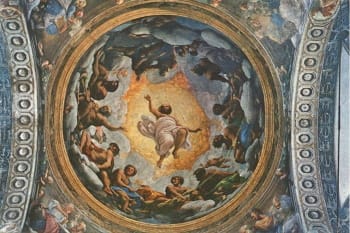
In 1520 Correggio began work on the cupola of the Benedictine church of San Giovanni Evangelista. The Vision of St. John on Patmos, which represents a narrative from the book of Revelations, showed the apostles in a circular arrangement around the outer edge, with clouds above and behind them, and at the center/apex of the work, Christ descends from the heavens, framed by a golden sky that appears to be glowing. The fresco secured Correggio many further important commissions. Like his later masterpiece, Assumption of the Virgin (1524-30), the swirling composition and skillful use of perspective gave the viewer the sense of being thrust upward into the heavens.
Waterhouse explains, how The Vision of St. John on Patmos (and Assumption of the Virgin) anticipated "the Baroque style of dramatically illusionistic ceiling painting" whereby the "entire architectural surface is treated as a single pictorial unit of vast proportions, equating the dome of the church with the vault of heaven". Indeed, as art historian Esperança Camara has pointed out, "In the sacred architecture of the Roman and Byzantine empires, domes were viewed as symbols of heaven".
Late Period and Death
Between 1526-30, Correggio produced what many believe to be his career defining fresco, the afore mentioned, The Assumption of the Virgin, which graced the dome of Parma's Cattedrale di Santa Maria Assunta. Here he had fully mastered a form of illusionistic foreshortening known as di sotto in su (from below to above) which influenced the future of religious dome frescos. Camara wrote: "Correggio's unusual and seemingly indecorous portrayal of Christ in extreme foreshortening, with his youthful legs exposed, draws attention to Christ's physicality, and thus both to his Incarnation through the Virgin Mary and his bodily presence in the Eucharist. Painted during the first decade of the Protestant Reformation, Correggio's fresco visually reaffirmed Catholic doctrines that had come under attack, in particular the doctrines of Transubstantiation [the changing of the elements of bread and wine into the body and blood of Christ], of Mary's status as intercessor, and of the Church's role in human redemption [...] The clergy, who gazed up [at Correggio's fresco] from the main altar or their seats in the choir, saw primarily the realm of heaven".
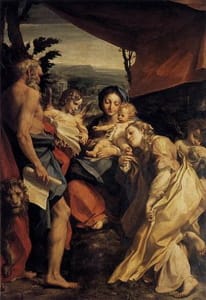
Waterhouse remarked, meanwhile, that, the remainder of Correggio's important works, though difficult to date with any certainty, fell into three categories: "the great altarpieces (and a few other large religious compositions); exquisite small works of private devotion; and a handful of mythological subjects of a lyrically sensuous character". Waterhouse adds that "Many of the altarpieces became so well known that they acquired nicknames. The Adoration of the Shepherds (c. 1530) is called Night (La Notte), and the Madonna of St. Jerome is popularly known as Day (Il Giorno). The late altarpieces are generally characterized by an intimate and domestic mood sustained between idealized figures. This intimate and homely poetry also distinguishes the small devotional works, such as The Madonna of the Basket and The Virgin Adoring the Child Jesus, while the Mystic Marriage of St. Catherine is a visual essay in the mid-16th-century aesthetic of ideal feminine beauty".
In the final years of his short life, Correggio returned permanently to his hometown of Reggio. By now he had turned away from religious subject matter and was focused more on mythological themes. Correggio conceived of his famous series of the loves of Jupiter, as described in Ovid's Metamorphoses, as a commission from Frederick the Great who wished to decorate his private "Ovid room". However, the works were gifted to the visiting Roman Emperor, Charles V. The series included Leda and the Swan, which was, according to Classics professor Herica Valladares, the most ¨sophisticated and sensuous" of all Correggio's works.
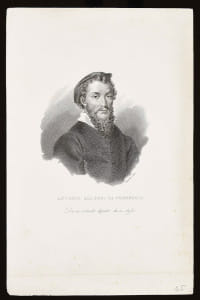
Our best understanding of Correggio "the man" comes from the account of his life by Vasari who described an artist whose low self-esteem belied the wonderful quality of his oeuvre. Vasari described Correggio as "very timid by nature [and] very melancholy in his practice of art [...] He was, in truth, a person who had no opinion of himself [who] contented with little, and [...] lived like an excellent Christian". Correggio passed away on March 5, 1534, although the tale of the circumstances of his death should perhaps be treated with a degree of skepticism. The story goes that the frugal artist had completed a commission in Parma for which he was paid in copper coins totaling sixty scudi, which was not an insignificant weight to carry by hand. To save on travel costs, Correggio opted to walk the 37 kilometers from Palma to his home in Reggio. An exhausted Correggio stopped in the blazing sun to drink water from a stream into which the artist then collapsed and drowned. What is certain is that he was buried one day after his death at his local church of San Francesco.
The Legacy of Antonio da Correggio
The famous Renaissance art historian, Giorgio Vasari, said of Correggio (despite some earlier reservations) that "Antonio most certainly deserved all praise and honour during his lifetime, and the greatest glory from the lips and pens of men after his death". Indeed, Correggio produced a highly decorative and dynamic narrative form that would come to exemplify the Baroque style. His pioneering use of di sotto in su foreshortening, for example, influenced later spectacular dome frescos including Gaudenzio Ferrari's Glory of Angels (1534-35) (Santa Maria dei Miracoli in Saronno), Giovanni Lanfranco's Assumption of the Virgin (1625-27) (S. Andrea della Valle in Rome), and Carlo Cignani's Assumption of the Virgin (1702-06) (the Forli cathedral in Romagna).
Waterhouse wrote: "Although his influence can be detected in later Parmese painting, especially in the Mannerist style of Parmigianino, Correggio had many imitators but no direct pupils who deserve mention". His decorative ideas were indeed taken up by the Baroque painters of the seventeenth century, but Correggio also became "almost a tutelary deity of the French Rococo style, and his great altarpieces were among the works most abundantly copied by the traveling artists of the 18th century during their years of study in Italy". The last word should perhaps go to Vasari who wrote, "Many things might be said of the works of this master; but since, among the eminent men of our art, everything that is to be seen by his hand is admired as something divine, I will say no more".
Influences and Connections

-
![Leonardo da Vinci]() Leonardo da Vinci
Leonardo da Vinci - Lorenzo Allegri
- Francesco Bianchi Ferrara
- Lorenzo Costa
- Francesco Francia
- Michelangelo Anselmi
- Cosimo Tura
- Isabella d'Este
-
![Anton Raphael Mengs]() Anton Raphael Mengs
Anton Raphael Mengs - Ercole Ferrata
- Carlo Cignani
- Gaudenzio Ferrari
- Giovanni Lanfranco
- Michelangelo Anselmi
- Cosimo Tura
- Isabella d'Este
Useful Resources on Antonio da Correggio
- Antonio Allegri Da Correggio, His Life, His Friends, and His TimeOur PickBy Corrado Ricci and Florence Simmonds
- Sketches of the Lives of Correggio and ParmegianoOur PickBy William Coxe
- Delphi Complete Works of Correggio (Illustrated) (Delphi Masters of Art Book 51)Our PickBy Peter Russell
- Renaissance Masters: The Art of Raphael, Michelangelo, Leonardo Da Vinci, Titian, Correggio, and BotBy George B. Rose
- Correggio: 70 DrawingsBy Narim Bender
- Correggio and Parmigianino: Art in Parma During the Sixteenth CenturyBy David Ekserdjian
- CorreggioBy Estelle May Hurll
 Ask The Art Story AI
Ask The Art Story AI